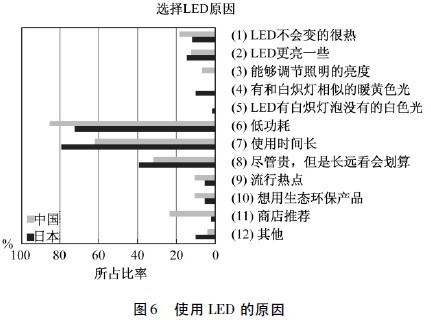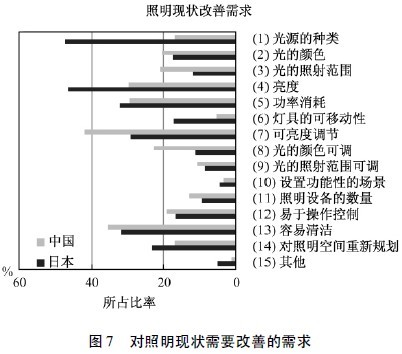1 Introduction
Lighting energy consumption accounts for 20% of the total energy consumption in the world. Lighting energy conservation is undoubtedly an important way to achieve energy conservation and emission reduction. In the field of residential lighting, as people's living standards improve, the requirements for lighting quality are gradually shifting from traditional “demand lighting†to “design lightingâ€. More and more lighting designs are integrated into residential lighting. Under the premise of meeting the needs of users' lives, the realization of green energy-saving lighting is maximized. At the same time, people's awareness of lighting has become an important factor in determining the energy-saving effect of lighting. China and Japan are the leading and consuming countries of Asian lighting, and undertake the important mission of spreading green lighting and developing low-carbon lighting. Therefore, research on residential lighting in China and Japan, real understanding of the status quo of residential lighting in the two countries plays an active and important role in promoting healthy lighting, energy saving and emission reduction, and the harmonious development of people and the natural environment.
Based on the Sino-Japanese residential lighting joint survey project, this paper investigates the lighting awareness of the residents of the two countries, the subjective evaluation of the lighting status of the houses, and the objective test. The purpose of this paper is to analyze the awareness of lighting and the status of residential lighting in the two countries. , differences, and room for improvement in residential lighting.
2 Sino-Japanese survey objects and conditions
In this survey, ordinary family houses in China and Japan were selected as survey objects. Among them, China surveyed 401 families from Dalian University of Technology teachers and college students. These include 200 households in Liaoning and Dalian, 106 households in other cities in Liaoning, and 95 households in Zhejiang, Hebei, Shaanxi, Henan, and Inner Mongolia. Japan surveyed 216 households with Nara Women's University, Shiga Prefectural University, Kyoto Women's University teachers and college students. Among them, there are 160 households in the Kansai region, 30 households in the central region, and 26 other households.

Table 1 shows the basic situation of the houses surveyed in China and Japan, including the family composition, construction year and construction area of ​​the house. Among them, for the family composition, China and Japan account for the largest proportion of the two generations of children, accounting for 51.9% and 67.2% respectively. Secondly, China is mainly composed of descendants and generations, about 19%, Japan. For the three generations of the descendants, accounting for 16.6%; in the residential construction year, China has a majority of residential houses in the past ten years, reaching 72.1%, and residential buildings in the 1990s was 21%, while Japan was the majority in the 1990s, accounting for 38.6%. The distribution in the rest of the year is relatively average; the building area of ​​the residential area is mainly concentrated in medium-sized units of 70 m2 to 120 m2, accounting for 61.1%. Japan has a relatively average distribution of the four areas.
For the objective test of residential lighting status, China and Japan use the same test objects, test equipment and test methods.
1) Test object: living room;
2) Test equipment: LX-1010B portable digital light meter;
3) Test method: The general illumination test uses the 5-point method, as shown in Figure 1. According to different lighting conditions, the corresponding pilots are selected and averaged. For the behavioral illumination, take the TV as an example, and test the behavioral illumination and the illumination of the working surface. The test method is shown in Figure 2.


3 Lighting awareness
The awareness of lighting is the awareness and awareness of residents' lighting, including the participation and satisfaction of residents in lighting design, the satisfaction and improvement requirements of the actual lighting state of the house, and the understanding of lighting knowledge.
3. 1 Participation and satisfaction with lighting design
Figure 3 shows the participation of residents of China and Japan in lighting design. As shown in Figure 3, when Chinese residents are lighting their homes, they pay more attention to the choice of lighting appearance and the location of the space. In Japan, the choice of lighting and light source is the main choice. As can be seen from the figure, Japanese residents are more concerned about the luminaire manufacturers than China, and to a certain extent can be understood as the recognition of the brand. Japanese residents pay attention to the quality and performance of lighting equipment, and can adapt to their own needs.
In the residential lighting design, the residents of China and Japan mainly rely on residential decorators, family members, and sales offices. Lighting designers are less involved. It shows that the ordinary residents of the two countries still stay at the level of traditional home decoration for lighting design, and their understanding of lighting design is not high.

Figure 4 shows the satisfaction and improvement of the actual lighting situation between Chinese and Japanese residents. Among them, China's satisfaction with the current lighting situation is 75%, 55% without improvement, and 25% for dissatisfaction. A total of 20%. Japan's satisfaction rate for lighting reached 85%, 53% did not need improvement, 15% for dissatisfaction, and 12% for improvement. Japan is more satisfied with the actual lighting situation, and for the unsatisfactory situation, the number of families needing improvement has reached 80%. Representing the residents of China and Japan to pay more attention to residential lighting, about 3 / 4 of the two countries believe that the existing lighting situation is more satisfactory, and 1/4 of the family feel that the lighting needs to be improved.
3. 2 Understanding of lighting knowledge
Figure 5 shows the understanding of lighting knowledge among residents of China and Japan. China's understanding of light sources and parameters is generally lower than that of Japan. The understanding of the light source in the two countries is much higher than the understanding of the lighting parameters. This indicates that residents have a higher awareness of the period of lighting and the type of light source at this stage, but the related unit parameters and their meanings and parameter concepts are still vague.

As shown in Figure 6, the main reason for the choice of LED Light source for residents in China and Japan is the low power consumption, long service life and long-term benefits of LED. It can be seen that LED as a new generation of light source is gradually accepted by more and more families. Among the recommended options for the store, China’s ratio exceeds 20% in Japan, indicating that China’s LED market promotion is bigger than Japan’s.

3. 3 Need for improvement in the current state of lighting
In the survey of the project that needs improvement in the current lighting situation, as shown in Figure 7, China needs to improve the current status of lighting in the top four. The brightness needs to be adjusted, easy to clean, brightness is not suitable, power consumption, and Japan is the light source. Type, brightness discomfort, power consumption, easy to clean, adjustable brightness, re-planning of lighting space. There are three common demand problems in China and Japan for easy cleaning, uncomfortable brightness, and power consumption. At different points, China's emphasis on brightness is adjustable, while Japan pays more attention to the choice of light source types and the importance of spatial planning.
